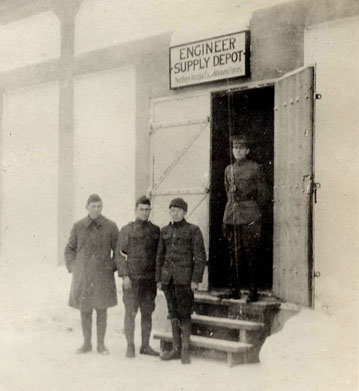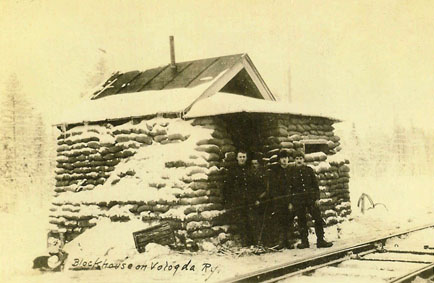 |
310th Engineers Supply Depot Group,
Archangel, Russia. no date. |
With the passing of the living history of the First World War, many of its significant events will fade from memory. Despite this loss, some still can name a few of the American experiences in this war, such as Belleau Wood or the “The Lost Battalion.” There was, however, one theater in which American soldiers and engineers served and fought that was forgotten long ago, even though it influenced the later events of the Cold War.
Shortly before the end of World War I, American and other Allied troops were deployed to Russia. Ostensibly, their mission was to protect donated war supplies in northern Russia and Siberia from German troops, to help Russia remain in the war, and to assist Allied prisoners of war in a chaotic, revolutionary Russia. In reality, the mission was never clear to American troops; even at the highest levels there was confusion. Secretary of War Newton Baker handed Maj. Gen. William S. Graves, commander of the American troops in Siberia, his orders with the words: "This contains the policy of the United States in Russia which you are to follow. Watch your step; you will be walking on eggs loaded with dynamite. God bless you and good-bye."
Accompanying the soldiers when they landed at Archangel, northern Russia, on August 2, 1918, and at Vladivostok, Siberia, on August 16, 1918, were Army engineers. In the case of northern Russia, the engineers were from the 310th Engineer Battalion. They served a crucial role in what became known as the Russian Expedition.
In the vast spaces of northern Russia and Siberia, railroads were critical, and Army engineers repaired and maintained them. They also constructed defensive fortifications, often using unique designs adapted to the bitter winter weather. In northern Russia, for example, engineers of the 310th constructed 316 log blockhouses and 273 machine gun emplacements. They also had to maintain equipment that was never meant to function in such harsh winters. Of course, they were also required to do battle in these same brutal conditions as fighting escalated between the Bolsheviks and supporters of the provisional government.
After World War I ended in November of 1918, the justification for maintaining a presence in Russia weakened and shifted. Ultimately, the lack of mission and domestic pressure led to the withdrawal of the 5,000 American soldiers in northern Russia in June of 1919. The following April, the 7,950 Americans in Siberia went home. When this obscure and little understood operation ended, it faded in American memory. Crucially, however, the Russians never forgot that American troops once fought on their soil. The experience, for them, very much influenced the direction the Cold War took in the aftermath of World War II.
 |
|
 |
| Blockhouse on Vologda Railway, Russia. no date. |
|
Drafting Room, Archangel, Russia. no date. |
* * *
The Office of History has in its collection a scrapbook of photos taken of the 310th Engineers while in Russia and a collection from William M. Black of the Allied Expeditionary Force, Siberia. This page presents some of those images that illustrate the conditions in Russia.
* * *
June 2009